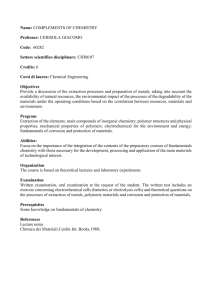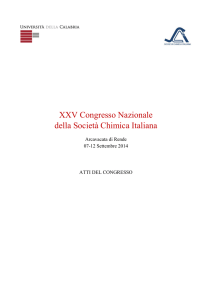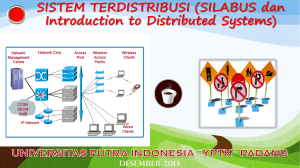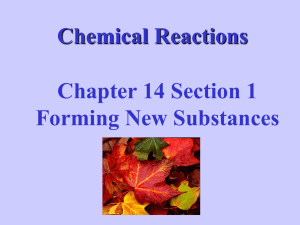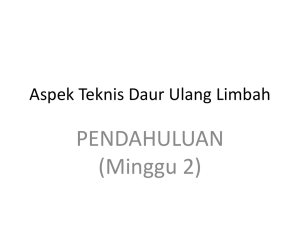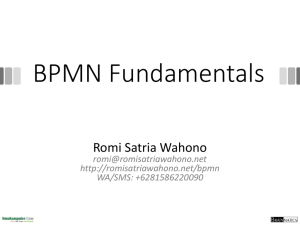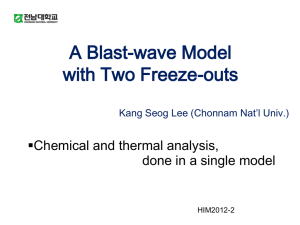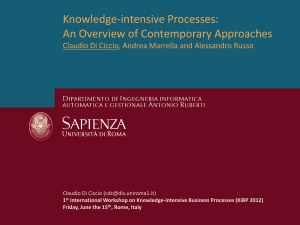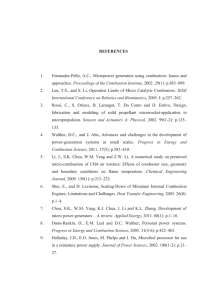Processes and Technologies for the valorization of wastes and
advertisement
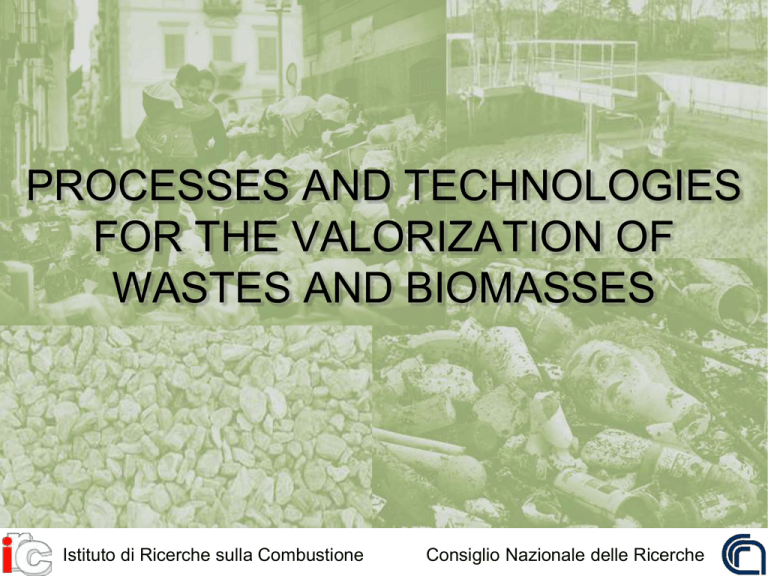
PROCESSES AND TECHNOLOGIES FOR THE VALORIZATION OF WASTES AND BIOMASSES Istituto di Ricerche sulla Combustione Consiglio Nazionale delle Ricerche THE FRAMEWORK • Design out waste • Build resilience through diversity • Rely on energy from renewable sources • Think in ‘systems’ • Waste is food Raw materials have NO or negative commercial value ii. The achievement of a zero economical/ecological balance is a win iii. Social perception is generally positive iv. There is an increasing interest to invest from good producers i. 2 MISSION Define, Enhance and Field-Test Processes and Technologies with the aim of realizing a sustainable nutrients cycle exploiting waste and residual biomasses resources with a focus on energetic issues STRATEGIES OF INTERVENTION Exploit the power of a combined approach in designing innovative multistep and multifaceted processes: - pretreatment - processing - reforming - combined renewable/waste/residues treatments - targeting of secondary raw material production to high added value application • metal recovery • catalytic materials • soils improvement 3 EXPERTISE, METHODOLOGIES AND INSTRUMENTS Expertise Diagnostics Design and realization of experimental systems from laboratory up to pilot scale. Processes diagnostics and control. Physical and chemical materials characterization. Catalytic processes and technologies. Computational reactive fluid dynamics. Advanced optical diagnostics Sizing, reactivity and surface properties of condensed matter from nano to macro size. Spectroscopy (IR, VIS, UV) Chromatography Microscopy Mass spectrometry Thermogravimetric analysis Laser diagnostics (PIV, PLIF) Mobility analysis Infrared Thermometry High speed imaging Processes Combustion Pyrolysis Gasification Bio-technologies Facilities Fermenters Pyrolyzers Gasifiers Burners Fixed and fluidized bed reactors (fully instrumented and up to the pilot scale). Computational resources. Chemical analysis laboratories. In-line ed off-line diagnostics and monitoring systems. 4 Researchers M. Alfè, C. Allouis, P. Ammendola, C. Branca, R. Chirone, S. Cimino, M. Commodo, I. Di Somma, M. de Joannon, A. Galgano, L. Lisi, F. S. Marra, F. Miccio, P. Minutolo, R. Ragucci, G. Ruoppolo, M.E. Russo, P. Sabia, F. Scala, O. Senneca, R. Solimene, M. Urciuolo CHALLENGES • Societal challenges • Secure, clean and efficient energy • Climate action, resource efficiency and raw materials LINE OF ACTIVITIES 1. Processes and Technologies for material recovery from wastes and biomasses 2. Processes and technologies for the energetic valorization of wastes and biomasses 5 COMMON ACTIVITIES MATERIALS AND PROCESSES CHARACTERIZATION • Standard – – – – Proximate analysis Ultimate analysis Inorganic content Morphology – TAR (UNI CEN/TS 15439) – Electron microscopy • Non Standard – Reactivity – Detailed chemical analysis using in house developed analytical methodologies and protocols for: GC-MS, HPLC, TG-MS, FTIR – In situ analysis in laboratory scale reactors NUMERICAL SIMULATION Experimental, theoretical and numerical studies aimed at better definition of: Chemical kinetics data Transport phenomena Fluid-dynamics Critical task for unconventional fuels and feedstocks. Process targeted approach PRE-TREATMENTS Grind Dry Make pellets Torrefy 6 7 – Waste and sludge suitable for biological fermentation – Lab scale process development and optimization – Syngas ready for chemicals production – Wide range of materials (Wastes, Endof-life, Biomasses.…) – Advanced monitoring and analysis tools – Oxygen carriers produced by sewage sludge fluidized bed combustion – Detailed fuel and products characterization – Fluid-dynamics and chemical kinetics optimization – Ash remediation Combustion Bio-technologies • Slow, fast and flash pyrolysis for: – material disposal (waste, contaminated biomasses, biofuel and agroindustrial byproducts …) – chemicals and secondary raw materials production • “Process to Plant Modeling” approach – chemical kinetics definition – transport phenomena effects – feedstock and process evolution interactions Gasification Pyrolysis Process and Technologies for material recovery from wastes and biomasses 8 – Solar energy and biotech combination – Lab scale process development and optimization – Advanced combustion processes for unconventional fuels – Fluidized bed – MILD burner – From elementary reactors to pre-pilot scale – Combustion and Co-combustion concepts – Very different fuels. Sludges, TAR, syngas, lignocellulosic matters – Detailed fuel and products characterization – Fluid-dynamics and chemical kinetics optimization Combustion Bio-technologies • “Process to Plant Modeling” approach – chemical kinetics definition – transport phenomena effects – feedstock and process evolution interactions – TAR reforming – Energy recovery from pyrolysis products – Feedstock preparation (pellettization, drying, torrefaction) – Wide range of materials (Wastes, End-of-life, Biomasses…) – Wide temperature range and carrier composition – Advanced monitoring and analysis tools – Gas cleaning • TAR reforming • particulates removal Gasification Pyrolysis Processes and technologies for the energetic valorization of wastes and biomasses PARTNERSHIP/PROJECTS • Collaborations: – Università di Napoli Federico II – Centro Sviluppo Materiali S.p.A – Broadcrown – Western University Canada – Gaia Energy – Solidea – Politecnico di Torino – Politecnico di Milano – Università di Salerno – Università della Calabria – Università di Messina – Technische Universität München – Fraunhofer UMSICHT – ENI 9 • Projects – Joint Paes Valle Caudina – Biopolis Distretti alta tecnologia – LIFE Ecoremed – PRIN RE-CYCLE Italy – “Processi innovativi per la produzione di energia da mix di biomasse e rifiuti speciali” – “Produzione di energia rinnovabile con il minimo impatto da un mix di biomasse e rifiuti speciali non pericolosi attraverso processi innovativi”
